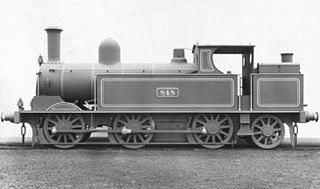George Whale was an English locomotive engineer who was born in Bocking, Essex, and educated in Lewisham, London. He worked for the London and North Western Railway (LNWR).
Locomotives of the London and North Western Railway. The London and North Western Railway (LNWR) Locomotive Department was headquartered at Crewe from 1862. The Crewe Works had been built in 1840–43 by the Grand Junction Railway (GJR).

The London and North Western Railway (LNWR) Webb Coal Tank is a class of 0-6-2T steam locomotive. They were called "Coal Tanks" because they were a side tank version of Webb's standard LNWR 17in Coal Engine, an 0-6-0 tender engine for slow freight trains.

The London and North Western Railway (LNWR) Improved Precedent Class or Renewed Precedent Class is a class of 2-4-0 steam locomotives originally designed for express passenger work. They later gained the nickname of Jumbos.

The LNWR 1185 Class was a class of 0-8-2T steam tank locomotives designed by Charles Bowen-Cooke and introduced in 1911. They passed into LMS ownership in 1923 and 8 survived to British Railways ownership in 1948. British Railways numbers were 47875-47896.

The LNWR 380 Class was a class of 0-8-4T steam tank locomotives designed by H. P. M. Beames. Although designed under the LNWR regime they appeared as LMS locomotives after the 1923 grouping. They were essentially an extended version of the 1185 Class 0-8-2T with a longer bunker, and were also related to the 0-8-0 freight engines. Their main area of work was to be in South Wales.

The London and North Western Railway (LNWR) Prince of Wales Class was a class of express passenger locomotive. It was in effect, a superheated version of the Experiment Class 4-6-0.

The London and North Western Railway (LNWR) George the Fifth Class was a class of 4-4-0 passenger steam locomotive.

The London and North Western Railway (LNWR) 19in Express Goods Class, otherwise known as the Experiment Goods Class was a class of 4-6-0 steam locomotives. They were essentially a smaller wheeled version of the Whale's Experiment Class and were an early attempt at a mixed traffic engine.

The London and North Western Railway (LNWR) Jubilee Class was a class of 4-4-0 4-cylinder compound locomotives by F.W. Webb. A total of forty were built from 1897–1900.

The LNWR 317 class, consisted of a class of 20 square saddle-tanked steam locomotives built by the London and North Western Railway at their Crewe Works between 1896 and 1901. They had a very short coupled wheelbase, with a trailing Bissel truck to carry weight.

The London and North Western Railway (LNWR) Waterloo Class was a class of 2-4-0 steam locomotives that was also known as the Whitworth Class.
Under the Whyte notation for the classification of steam locomotives, 2-2-2-0 usually represents the wheel arrangement of two leading wheels on one axle, four powered but uncoupled driving wheels on two axles, and no trailing wheels, but can also be used to represent two sets of leading wheels two driving wheels, and no trailing wheels. Some authorities place brackets around the duplicated but uncoupled wheels, creating a notation 2-(2-2)-0, or (2-2)-2-0, as a means of differentiating between them. Others simply refer to the locomotives 2-2-2-0.

The London and North Western Railway (LNWR) Special Tank was a class of 0-6-0ST steam locomotives. They were a saddle tank version of the LNWR DX Goods class. A total of 278 locomotives were built from 1870 onwards, of which five survived to be inherited by British Railways in 1948. These five were in departmental stock: four – numbered 3, 6, 7 (2329) and 8 Earlstown (2359) – as Carriage Department shunters at Wolverton Works; and No. 3323, a shunter at Crewe Works.

The London and North Western Railway (LNWR) 4ft Shunter was a class of 0-4-0ST steam locomotives. Introduced in 1863 by Ramsbottom, 26 were built in 1863–1865, 10 in 1870, 10 in 1872, and 10 in 1892. The last three of the latter batch were soon rebuilt as 0-4-2ST crane tanks. They survived into LMS ownership in 1923 and the last one was withdrawn in 1933.

The London and North Western Railway (LNWR) 7 ft 6 in Single 2-2-2 class was a type of express passenger locomotive designed by John Ramsbottom. The class is better known as the Problem class for the first locomotive built, or the Lady of the Lake class for the example that was displayed at the International Exhibition of 1862.

The LNWR 18-inch Goods was a class of 310 0-6-0 freight steam locomotives built by the London and North Western Railway at their Crewe Works between 1880 and 1902.

The LNWR 18-inch Tank class was a class of 80 0-6-2T locomotives built by the London and North Western Railway in their Crewe Works between 1898 and 1902.

The LNWR Newton Class was a class of ninety-six 2-4-0 steam locomotives built by the London and North Western Railway at their Crewe Works between 1866 and 1873.

The LNWR Samson Class was a class of ninety 2-4-0 steam locomotives built by the London and North Western Railway at their Crewe Works between 1863 and 1879.


















